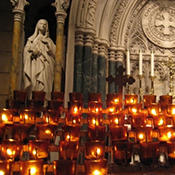 For Christians, the word “church” refers both to Christian communities (ranging from single congregations to all of the religion’s adherents across time and space) and to the buildings where they gather to worship, pray, and fellowship together. These structures also vary in size, from single-room sanctuaries to immense megachurches.
For Christians, the word “church” refers both to Christian communities (ranging from single congregations to all of the religion’s adherents across time and space) and to the buildings where they gather to worship, pray, and fellowship together. These structures also vary in size, from single-room sanctuaries to immense megachurches.
View full album
“The church” is both a building and a community, a space and a spirit. The spirit of community is created and expressed ritually when the community gathers. “The peace of Christ be with you,” the minister might say, smiling broadly and opening her arms toward the congregation. “And also with you,” the people respond. She beckons, “Let us greet one another with a sign of peace.” What follows in Christian churches all across America is an informal moment embedded in the midst of a formal Sunday service, when worshipers turn toward one another with a warm handshake, a hug, perhaps even a kiss, and a word of peace. “Peace be with you,” they say. For a few moments, the congregation’s rows break into a buzz of greeting and embrace. It is this spirit of shared commitment to Christ and to one another that makes this gathering for worship a “church.” Above all else, the church is a community of people.
As for the church building, there are as many kinds of American churches as there are church communities and regional cultures. The Southwest has its old adobe churches; the Rocky Mountains have their log-cabin churches. In urban areas, one may find a storefront church with its Hispanic Pentecostal congregation, and a Catholic urban mission, operating out of a former movie theater, its marquee now announcing mission programs. The elegant austerity of the old New England Congregationalists still persists in the countless white clapboard churches, steeple pointing heavenward, the interior unadorned. Other churches, like the National Cathedral in Washington, DC, preserve a Gothic style reminiscent of the cathedrals of Europe. They create an atmosphere of awe, majesty, and mystery, the sanctuary itself lifting the attention of the worshiper toward the heavens. There are modern-day cathedrals as well, such as the Crystal Cathedral in Anaheim, California, a glass and glitter American-style cathedral within a few miles of Disneyland. Built by televangelist Robert Schuller in 1980, the Crystal Cathedral was sold to the Roman Catholic Diocese of Orange in 2010 after Schuller’s church—which claimed 10,000 members at its peak—filed for bankruptcy.
Especially in the past twenty years, many large, established, urban churches have become home to multiple congregations. Some call these congregations “nesting” churches, new immigrant church communities that make their nest, so to speak, within the structure of another church. There are tens of thousands of such churches today. For example, a Chinese-speaking congregation shares space with an English-speaking United Church of Christ in Flushing, Queens. They worship separately, the English-speaking congregation in the sanctuary, the Chinese-speaking one in the fellowship hall; but the two congregations meet together for the social hour after the services. In other multi-congregational churches, Korean or Samoan congregations might use the sanctuary for an afternoon or evening service. In this way, America’s newest immigrants have started a multitude of Vietnamese Catholic, Korean Presbyterian, and Chinese evangelical churches.
Every church building contains more than a sanctuary. There are kitchens and fellowship halls, classrooms and libraries. In the late 20th century, however, an entirely new and even more comprehensive church “campus” emerged with the advent of huge “megachurches.” Entering Second Baptist Church in Houston, for example, one might feel more like one had entered a large office complex than a sacred space. There are escalators and closed-circuit television monitors. The enormous sanctuary seats more than a thousand people and the facilities include a fitness center, a bookstore, and a college preparatory school for grades K-12. The Woodway campus, one of five branches, even hosts a restaurant featuring indoor and outdoor seating.
The Willow Creek Community Church in South Barrington, Illinois, takes a further step. While churches have traditionally served a town, neighborhood, or parish, the sprawling suburbs of today’s cities have produced what is now called a “commuter” church. By design, the 141-acre South Barrington campus looks more like a community college than a traditional church. Gone are the pews and the chancel. Entering this sanctuary is more like entering an auditorium where over 4,500 people can be seated in theater-style seats, focused not on the altar, but on a stage where a singing group leads the community in easy-to-learn Christian music. The entire “church experience” appeals to many people who might otherwise not be attracted to church at all. Indeed, it proved so appealing that Willow Creek now includes eight suburban campuses, a Spanish-speaking “regional” at its South Barrington location, and–expanding beyond its suburban base–an urban campus in Chicago.
For communities such as Willow Creek and the Second Baptist Church in Houston, both the church buildings and the experience have come to embrace more and more of the members’ day-to-day lives. And just like the storefront church, nesting congregations, and gothic cathedrals, their spaces have evolved with their contexts in order to sustain and expand Christian community.